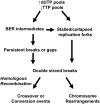Uracil in DNA: consequences for carcinogenesis and chemotherapy
- PMID: 18599024
- PMCID: PMC2562027
- DOI: 10.1016/j.bcp.2008.05.019
Uracil in DNA: consequences for carcinogenesis and chemotherapy
Abstract
The synthesis of thymidylate (TMP) occupies a convergence of two critical metabolic pathways: folate metabolism and pyrimidine biosynthesis. Thymidylate is formed from deoxyuridylate (dUMP) using N(5),N(10)-methylene tetrahydrofolate. The metabolic relationship between dUMP, TMP, and folate has been the subject of cancer research from prevention to chemotherapy. Thymidylate stress is induced by nutritional deficiency of folic acid, defects in folate metabolism, and by antifolate and fluoropyrimidine chemotherapeutics. Both classes of chemotherapeutics remain mainstay treatments against solid tumors. Because of the close relationship between dUMP and TMP, thymidylate stress is associated with increased incorporation of uracil into DNA. Genomic uracil is removed by uracil DNA glycosylases of base excision repair (BER). Unfortunately, BER is apparently problematic during thymidylate stress. Because BER requires a DNA resynthesis step, elevated dUTP causes reintroduction of genomic uracil. BER strand break intermediates are clastogenic if not repaired. Thus, BER during thymidylate stress appears to cause genome instability, yet might also contribute to the mechanism of action for antifolates and fluoropyrimidines. However, the precise roles of BER and its components during thymidylate stress remain unclear. In particular, links between BER and downstream events remain poorly defined, including damage signaling pathways and homologous recombination (HR). Evidence is growing that HR responds to persistent BER strand break intermediates and DNA damage signaling pathways mediate cross talk between BER and HR. Examination of crosstalk among BER, HR, and damage signaling may shed light on decades of investigation and provide insight for development of novel chemopreventive and chemotherapeutic approaches.
Figures




References
-
- Powers HJ. Interaction among folate, riboflavin, genotype, and cancer, with reference to colorectal and cervical cancer. J Nutr. 2005;135:2960S–6S. - PubMed
-
- Costi MP, Ferrari S, Venturelli A, Calo S, Tondi D, Barlocco D. Thymidylate synthase structure, function and implication in drug discovery. Curr Med Chem. 2005;12:2241–58. - PubMed
-
- Parker WB, Cheng YC. Metabolism and mechanism of action of 5-fluorouracil. Pharmacol Ther. 1990;48:381–95. - PubMed
-
- Ahmad SI, Kirk SH, Eisenstark A. Thymine metabolism and thymineless death in prokaryotes and eukaryotes. Ann Rev Microbiol. 1998;52:591–625. - PubMed
-
- Eriksson S, Arner E, Spasokoukotskaja T, Wang L, Karlsson A, Brosjo O, et al. Properties and levels of deoxynucleoside kinases in normal and tumor cells; implications for chemotherapy. Adv Enzyme Regul. 1994;34:13–25. - PubMed
Publication types
MeSH terms
Substances
Grants and funding
LinkOut - more resources
Full Text Sources

